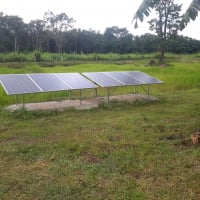Rotating batteries in a battery bank!
Comments
-
I have an electric two wheeler where 4 batteries of 12 Vdc are connected in series. Assuming the present status as 1-2-3-4, when I rotate, what should be the next sequence, 2-1-4-3 or 2-3-4-1 or some other combinations. What should be my next 4 sequences. Thanks in advance.
-
There would be little to no advantage in rotating the batteries if connected in series, other than some physical exercise.1500W, 6× Schutten 250W Poly panels , Schneider MPPT 60 150 CC, Schneider SW 2524 inverter, 400Ah LFP 24V nominal battery with Battery Bodyguard BMS
Second system 1890W 3 × 300W No name brand poly, 3×330 Sunsolar Poly panels, Morningstar TS 60 PWM controller, no name 2000W inverter 400Ah LFP 24V nominal battery with Daly BMS, used for water pumping and day time air conditioning.
5Kw Yanmar clone single cylinder air cooled diesel generator for rare emergency charging and welding. -
It should not matter where the batteries are in the series string.
However, there have been some folks that swear that their batteries do not stay balanced (equal voltage) over time ries and do rotate their batteries. One battery (for example) near the positive end of the string seems to be lower, and another battery at the negative end of the string is higher voltage... So switching those two batteries once per year seems to work for them.
In general, there is no reason that the battery position in a series string should matter... But, I guess, things like battery temperature, can be different between physical locations (one position runs "hotter" because of less air circulation, near a hot motor, etc.).
So--That is what I would do. Take a voltmeter and measure the resting battery voltages. And I would switch the higher voltage battery with the lower battery voltage and see if that makes things better (for example, if you have a "bad" battery, then it would not matter where it is physically in the string--It is still a bad battery).
You may also want to review your battery charging (charging voltage, time on charge, battery temperatures, battery type, etc.). If you are having problems with batteries not staying balanced, an EQ charge (or manual balancing of the batteries) may be needed. If you have a failing battery, then replacement of the battery (or the whole string, if the batteries are old/weak in general) may be the best solution.
-BillNear San Francisco California: 3.5kWatt Grid Tied Solar power system+small backup genset -
Sounds like under charging and not doing enough EQ time, or wiring. The usual suspects from Casablanca."we go where power lines don't" Sierra Nevada mountain area
htps://offgridsolar1.com/
E-mail offgridsolar@sti.net -
2-1-4-3 -> 4-3-2-1
+1 on the thermal effects of battery location (sandwiched in the middle or on the end). A few degrees is significant in chemical reactions.
It would be interesting to see a 48V charger that was actually four 12V chargers and would enforce between battery balance without the damaging effects of equalization. Or just buy a balancer (eg, HA02).
I am available for custom hardware/firmware development
-
Another possible reason to rotate would be if some 12v loads (eg lights or accessories) are being taken off part of a 48v string. It isn't really the right way to power lower voltage loads, but it's sometimes done and can cause uneven charging.
Are the batteries AGM, flooded, lithium, or?Off-grid.
Main system ~4kw panels into 2xMNClassic150 370ah 48v bank 2xOutback 3548 inverter 120v + 240v autotransformer
Night system ~1kw panels into 1xMNClassic150 700ah 12v bank morningstar 300w inverter -
I checked my battery’s temp the other day at full charge it was 15o F out side in my garage it was 37o in the utility room where the air from my battery box ventilator comes from the temp is 57o .I have 16 6 V batteries in two strings in the corner of the garage the voltage on all batteries are very close , most of the batteries in the enclosure Where 51 to 51.5 o the 2 battery’s on the end neg side of the string was sitting at 49and 49.5 , so 4 battery’s on the outside of the Enclosure are definitely colder would this mak a difference ? I think cooler battery’s would get less charge .Out back flex power one with out back 3648 inverter fm80 charge controler flex net mate 16 gc215 battery’s 4425 Watts solar .
-
I see heat as a problem in that battery box. I would probably install a couple 3-4" muffin fans that only run during daylight hours.
I can see people removing corrosion and re-tightening connections when they rotate their batteries. Clearly that helps.
Copper water plumbing pipe at hardware stores is 99.9% copper. With a large vise and ~4 lb. hammer one can make excellent bus bars and connectors. I like to wrap empty spaces with rubber tubing to increase the safety factor.
Spray terminals with battery terminal protection such as: https://www.amazon.com/Deka-00320-Battery-Terminal-Protection/dp/B008QEPGEW/ref=sr_1_30?crid=1W66AWP0ZQ287&keywords=battery+terminal+protector+spray&qid=1575559681&sprefix=battery+terminal,aps,288&sr=8-30
Felt battery terminal washers over automotive style 17mm and 19mm posts also absorbs battery mist before it creates corrosion. https://www.amazon.com/STEELMAN-96992-Terminal-Protectors-Batteries/dp/B07PQYHSM6/ref=sr_1_18?crid=1W66AWP0ZQ287&keywords=battery+terminal+protector+spray&qid=1575559939&sprefix=battery+terminal,aps,288&sr=8-18
A few of these notes are general battery maintenance notes that also work well on auto batteries.First Bank:16 180 watt Grape Solar with FM80 controller and 3648 Inverter....Fullriver 8D AGM solar batteries. Second Bank/MacGyver Special: 10 165(?) watt BP Solar with Renogy MPPT 40A controller/ and Xantrex C-35 PWM controller/ and Morningstar PWM controller...Cotek 24V PSW inverter....forklift and diesel locomotive batteries -
It seems to me the temp variance could be; 1. Heat produced during the latter stage of charging and/or 2. Changes in ambient temp taking longer for interior batteries vs those with more surface exposed to ambient.
It seems to me a couple degrees F isn't enough to lose sleep over. If the diff is more from #2 above, it might even out over the year (interior batts warmer in winter, but cooler in summer).
In either case, if there's room and wire length to do it, leaving space between batteries might help more than more ventilation. More ventilation would get the outside batts to ambient faster, potentially making more temp difference between batteries rather than less.
Off-grid.
Main system ~4kw panels into 2xMNClassic150 370ah 48v bank 2xOutback 3548 inverter 120v + 240v autotransformer
Night system ~1kw panels into 1xMNClassic150 700ah 12v bank morningstar 300w inverter -
We would seem to have some members who miss the forest due to the leaves - at times.First Bank:16 180 watt Grape Solar with FM80 controller and 3648 Inverter....Fullriver 8D AGM solar batteries. Second Bank/MacGyver Special: 10 165(?) watt BP Solar with Renogy MPPT 40A controller/ and Xantrex C-35 PWM controller/ and Morningstar PWM controller...Cotek 24V PSW inverter....forklift and diesel locomotive batteries
Categories
- All Categories
- 233 Forum & Website
- 141 Solar Forum News and Announcements
- 1.4K Solar News, Reviews, & Product Announcements
- 199 Solar Information links & sources, event announcements
- 899 Solar Product Reviews & Opinions
- 256 Solar Skeptics, Hype, & Scams Corner
- 22.5K Solar Electric Power, Wind Power & Balance of System
- 3.5K General Solar Power Topics
- 6.7K Solar Beginners Corner
- 1K PV Installers Forum - NEC, Wiring, Installation
- 2.1K Advanced Solar Electric Technical Forum
- 5.6K Off Grid Solar & Battery Systems
- 429 Caravan, Recreational Vehicle, and Marine Power Systems
- 1.1K Grid Tie and Grid Interactive Systems
- 656 Solar Water Pumping
- 816 Wind Power Generation
- 624 Energy Use & Conservation
- 621 Discussion Forums/Café
- 314 In the Weeds--Member's Choice
- 75 Construction
- 124 New Battery Technologies
- 108 Old Battery Tech Discussions
- 3.8K Solar News - Automatic Feed
- 3.8K Solar Energy News RSS Feed


